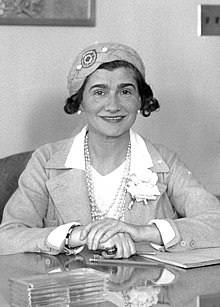Coco Chanel
Gabrielle Bonheur "Coco" Chanel (19 August 1883 – 10 January 1971)[1] was a French fashion designer. She was a founder of the House of Chanel. She was the only fashion designer to be named on TIME Magazine's 100 most influential people of the 20th century.[2] She broke free of conventions and became a role model for some. Her behaviour during the German occupation of France in World War II led to criticism.[3]

Background
changeChanel was born in 1883 in Saumur, France. In her youth, she was a seamstress and a nightclub singer.[4] Her stage name was Coco, so she used that name publicly.[5]
In 1910, she opened a hat shop. In 1919, she opened a house of fashion in Paris, and introduced her perfume, Chanel No. 5, in 1921. She retired in 1939, but returned to fashion with great success in 1954.[6]
She is famous for the little black dress, Chanel No. 5, the most famous women's perfume in the world, and the knee-long skirt and box jacket suit worn with pearl necklace.
First shops
changeIn 1913, Chanel opened her first shop in Deauville, France. Society women liked her simple wardrobe. In 1915, she opened a second shop in Biarritz.
Chanel became one of the first women fashion designers to create simple and practical clothes for the sporty women of the era. She took the color black, which was not used in fashion at the time and showed "chic" it could be by wearing it. The material jersey was usually used to make men's underwear, but Chanel started to work with it to make women's fashion.[1] Archived 2009-11-27 at the Wayback Machine Short hair, tans, and casual styles were the new trends.[7] She banned corsets and other uncomfortable garments.[8]
Personal life
changeChanel was the mistress of several rich men. During her relationship with the Grand Duke Dmitri Pavlovich of Russia in 1920, she added a Russian touch to her dresses by embroidering Russian patterns on them.[7]
Chanel was with Hugh Grosvenor, from 1924 to 1931. During this time, she discovered the English tweed sweater, English men's suits, and English coats. She added these to her collections.[7]
World War II
changeChanel lived at the Hotel Ritz in Paris for over thirty years. During World War II, the Nazis occupied Paris, and her shops were closed. She had an affair with a Nazi officer, and was accused of being a collaborator.[4]
She moved to Switzerland when France was freed from Nazi rule in 1944.
After a 15-year gap, Chanel returned to fashion in 1954. She was shocked to see the new fashion trends, especially those by Christian Dior. She understood better than anyone the requirements and needs of an active woman’s lifestyle. Her 'comeback' collection was in 1954.[9]
Media
changeHer life was depicted in the Broadway musical Coco in 1969. Movies based on her life include: Chanel Solitaire (1981), Coco Chanel (2008), Coco Before Chanel (2009), and Coco Chanel & Igor Stravinsky (2009). Chanel also liked drinking cocoa during interviews. She always said she felt better after a few sips.
Today
changeChanel died in 1971. She is still influencing women’s lifestyles and clothing. The House of Chanel remains in business. It is a member of the Chambre syndicale de la haute couture, the top fashion clique in Paris. The House of Chanel produces modern versions of her best ideas.[9]
References
change- ↑ "Madamoiselle Chanel: the perennially fashionable". Chanel. Retrieved 2006-10-13.
- ↑ Horton, Ros; Simmons, Sally (2007). Women Who Changed the World. Quercus. p. 103. ISBN 978-1-84724-026-2.
- ↑ Vaughan, Hal 2011. Sleeping with the enemy: Coco Chanel's secret war. New York: Knopf. ISBN 978-0-307-59263-7
- ↑ 4.0 4.1 Charles-Roux, Edmonde. 1975. Chanel: her life, her world, and the woman behind the legend she herself created. New York: Alfred A. Knopf, distributed by Random House. ISBN 0-394-47613-1,
- ↑ "Coco Chanel". Biography. Retrieved 2018-03-13.
- ↑ Jean Druesedow. 2012. The World Book Encyclopeida. Volume 3.
- ↑ 7.0 7.1 7.2 Coco Chanel bio.com
- ↑ Coco Chanel biography, Bio true story, p.1
- ↑ 9.0 9.1 Picardie, Justine 2011. Coco Chanel: the legend and the life. HarperCollins, 'The Comeback', p269 et seq.